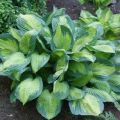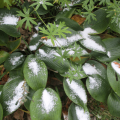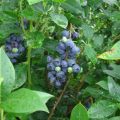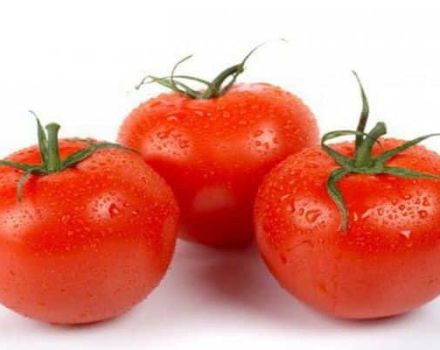Description and characteristics of Blue Angel hosts, planting rules and care
The lush bushes of the Blue Angel hosts are prized for their decorative coloration and leaf shape. Florists incorporate culture into original bouquets, use plants in landscaping, bringing an island of tropical flora to gardens and home gardens.
Description and features
Under favorable conditions, the giant hosta variety Blue Angel or Blue Angel grows up to 80–100 cm with a bush width of 1.2 m. Peduncles with white funnel-shaped flowers rise above the heart-shaped leaves 40 cm long and 30 cm wide. In spring, the color of the corrugated leaf plates with pronounced venation is bluish-blue. In autumn, the color of the leaves transforms into a rich green.
A perennial herb, Blue Angel, after flowering forms capsules with 3 mm seeds. The culture pleases with flowering over the last two summer months.
Breeding history
The blue hybrid Blue Angel was obtained by a Dutch breeder in 1986. To obtain a new variety, Paul Aden re-pollinated Aden varieties numbered 361 and 365.
Features of agricultural technology in the open field
Before landing, the Blue Angel hosts in the open ground are determined with a place, the choice of suitable conditions. For the normal development and reproduction of hosts, adherence to the planting technology, the rules for the implementation of agrotechnical measures is required.
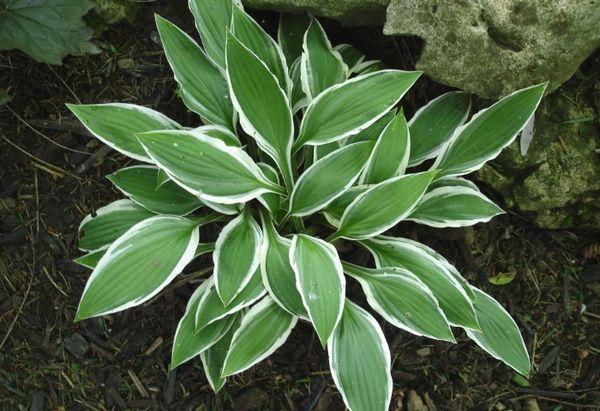
Choosing a landing site
A suitable soil for the host is slightly acidic, nutritious, drained. An important condition is water permeability and aeration of the earth. Sandy and loamy soils are not suitable.
Hosts do not grow in pots at home, as the plant needs a dormant period at low outdoor temperatures to develop, bloom and reproduce.
Illumination requirements
Hosta Blue Angel belongs to shade-loving varieties. When exposed to direct sunlight, the leaf plates lose their distinctive color and merge with neighboring greenery, so an open sunny area is not suitable for the variety. The ideal place is partial shade under the crowns of trees.
Reproduction
There are 3 known ways to reproduce the Blue Angel - by seeds, cuttings, dividing the bush. The last option is the most effective and does not take much time.

Seed germination is average, but there is no guarantee of maintaining varietal characteristics.
Landing Algorithm:
- before sowing, the planting material is kept in a growth stimulator;
- the earth is calcined or disinfected with a manganese solution;
- a drainage layer is laid on the bottom of the container;
- moisturize the nutrient substrate;
- scatter seeds superficially, sprinkling with a thin layer of earth.
The process of growing from seed to full bloom of the bush takes 4 years.
Cuttings are carried out during the summer period. A young shoot is separated with a leaf, which is cut off by 1/3. Further, the cutting is planted in partial shade, regularly moistening. To create a greenhouse effect and fast rooting, a plastic bottle with a cut bottom is placed on top.
The bush is divided at the end of August after bud formation or in early spring. The rhizome is cut with a shovel so that 2 sockets remain in each section. The cut points are treated with crushed activated carbon or wood ash, and immediately planted in a permanent place.
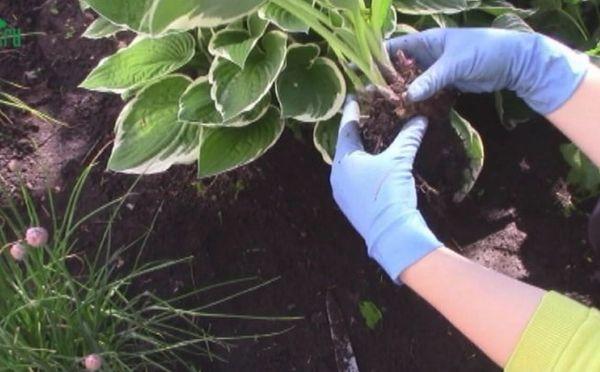
How to plant
Blue angel hosta bushes grow up to 1.2 m wide. Based on this, the distance between plantings is maintained at least 1.5–2 m. When planting plants in autumn, it is taken into account that the culture takes root for 2 weeks in warm weather.
Before the event, the soil is dug onto the bayonet of a shovel, complex fertilizers are applied. Provide the width of the planting pit twice the volume of the roots, lay drainage.
When planting, the roots are straightened, covered with earth so that the root collar is located at the same level with the soil surface. The earth is lightly tamped, watered and mulched with sawdust and bark.
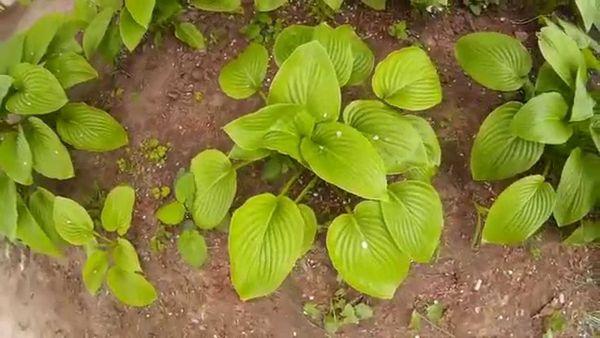
Care rules
Caring for the Blue Angel host is not burdensome, but requires adherence to the following recommendations:
- for fertilization, plants annually mulch the soil around the crop with compost;
- feeding is done twice a season - in the spring the host needs nitrogen (solution of mullein, chicken droppings), in the fall, potassium and phosphorus are added under the bushes;
- weeds are weeded at the beginning of the growing season;
- irrigate the host as needed, excluding the ingress of water droplets on the leaf plates.
The Blue Angel Bush looks more neat and compact when the stems are removed.
Before the onset of frost, the ground part of the plant is cut off; the culture does not need warming measures.
Diseases and pests
Common diseases of the Blue Angel hosts:
Virus X (HVX)
The appearance of strokes, spots, small inclusions on the host should alert the gardener. Such drawings do not correspond to varietal characteristics, but refer to signs of damage to the Hosta Virus X (HVX) culture.
The disease leads to interveinal chlorosis, dwarf bushes, and later to the death of the plant. The virus cannot be treated, so the infected bushes are removed from the garden and taken out of the garden.
Hosta Virus X (HVX) enters host tissues through wounds and leaf cuts when pruning and dividing bushes through contact with non-disinfected garden tools.

Root collar rot
The disease is diagnosed by yellowing and discoloration of the leaf plates. The neglected stage of the disease leads to the death of the culture.
Noticing yellow leaves, the plant is dug up. The root is washed and inspected, areas of dust and rot are cut out, the sections are disinfected with fungicides. The host is transplanted to a new location.
Phylosticosis
Gradually merging brown spots with black blotches are the first symptoms of phylosticosis. Later, an ashy bloom of fungal spores forms on the leaves, the leaf dries up and dies.
The Phyllosticta fungus selects weakened, poorly overwintered plants. Treatment includes moderate irrigation, removal of damaged parts of the crop and the use of fungicides - Abiga-Peak, Strobi, copper sulfate
Gray rot
Spores of the fungus Botrytis infect the leaves from the edges towards the center of the leaf blade. The affected areas are covered with a gray bloom, rot, dry out.
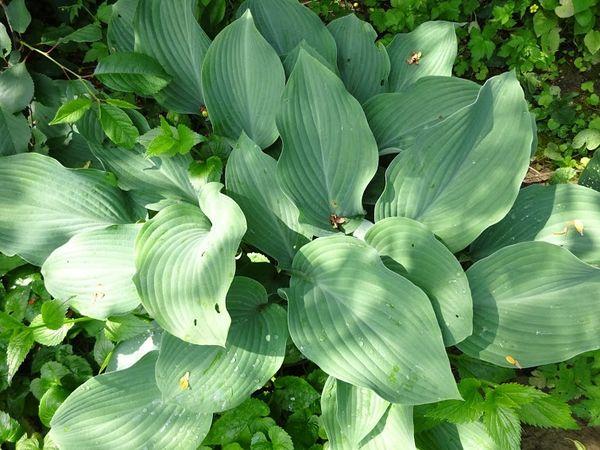
At the initial stage of the disease, the hostu Blue Angel is treated with Topaz, Fundazol, Skor, spraying the bushes three times every 10-14 days. In an advanced stage, gray rot is not treated.
Of the pests, slugs cause more damage to the host.Molluscs begin to gnaw holes in the plant as soon as the first spring shoots appear.
Sawdust, tobacco, lime are brought under the bushes, traps are set. If folk recipes are powerless, use granular preparations Slug-Eater, Thunderstorm.
Advantages and disadvantages of the variety
Pros of the Blue Angel hosta variety:
- unpretentiousness to the composition of the air - the plant feels good in urban areas;
- decorativeness of bushes;
- high built-in immunity, resistance to fungal diseases;
- frost resistance;
- temporary drought resistance;
- unattractiveness to insect pests.
There are no obvious flaws behind the Blue Angel host.
The culture is used to decorate artificial reservoirs, planted along the curbs, next to the entrance to the gazebo. Plants dilute planting primroses, phlox.
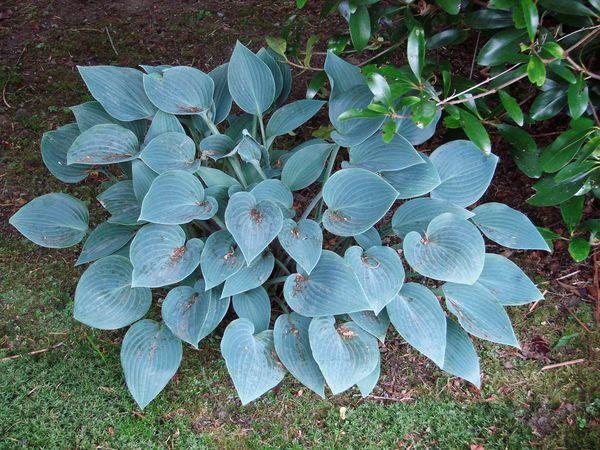
If you plant the Blue Angel variety next to crocuses, daffodils, then at the end of the flowering of the primroses, the hosta bushes will fill the empty spaces in the flower bed.
Analogs
Analogs of hosts Blue angel:
- Fond Hope is blue-gray with light ripples on the plates;
- Blue Mammoth (Blue Mammoth) stands out for flowering large white flowers;
- More Elegant - hosta with blue bubble leaves;
- Prince of Wales (Prince of Wales) has very large blue-green leaf plates;
- Headliner (Headliner) grows into a medium-sized bush with purple flowers;
- Snowden is a giant variety with blue-green leaves reaching a height of 1.2 m.
In landscape design, group plantings of different varieties of blue hosts look beautiful.
Reviews
The hosts learn about the real advantages and disadvantages from the reviews of florists.
Alena, 36 years old, Moscow:
I got carried away with the cultivation of herbaceous plants 3 years ago. I planted 4 host varieties. Among them, the Blue Angel variety stands out for its large gray leaves and abundant long flowering. No wonder the culture is called the wonder host.
Tamara Ivanovna, 46 years old, Kiev:
Had the imprudence to plant Blue Angel in the sun. At the initial stage, the host is pleased with the blue, you can't take your eyes off. But by July the leaves turn green, the magic of culture disappears.
Tatiana, 33 years old, Zaporozhye:
She decorated the Blue Angel with the host of the banks of the pond dug by her husband in the country. I am not overjoyed at this elegant unpretentious plant. This year, we plan to plant a blue hosta at the entrance to the greenhouse and in a flower bed with primroses.



